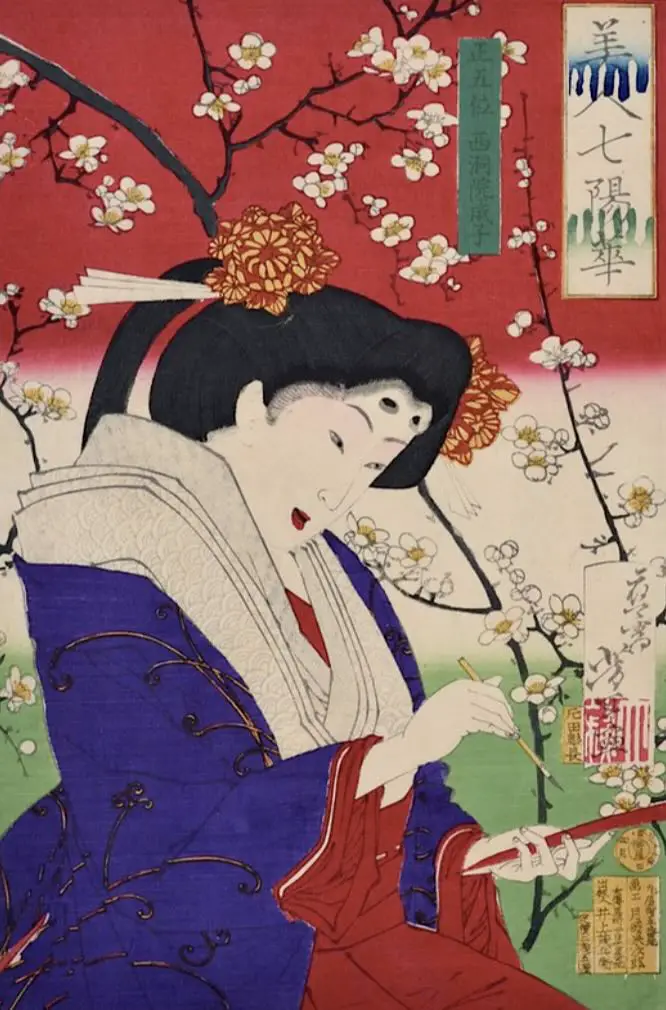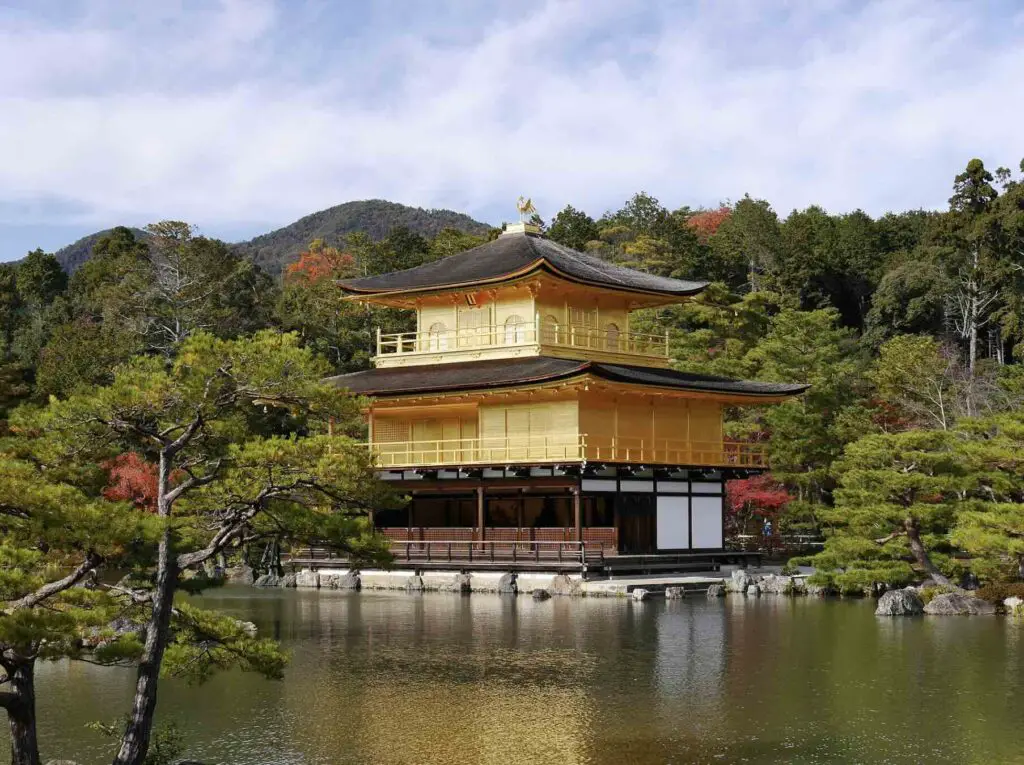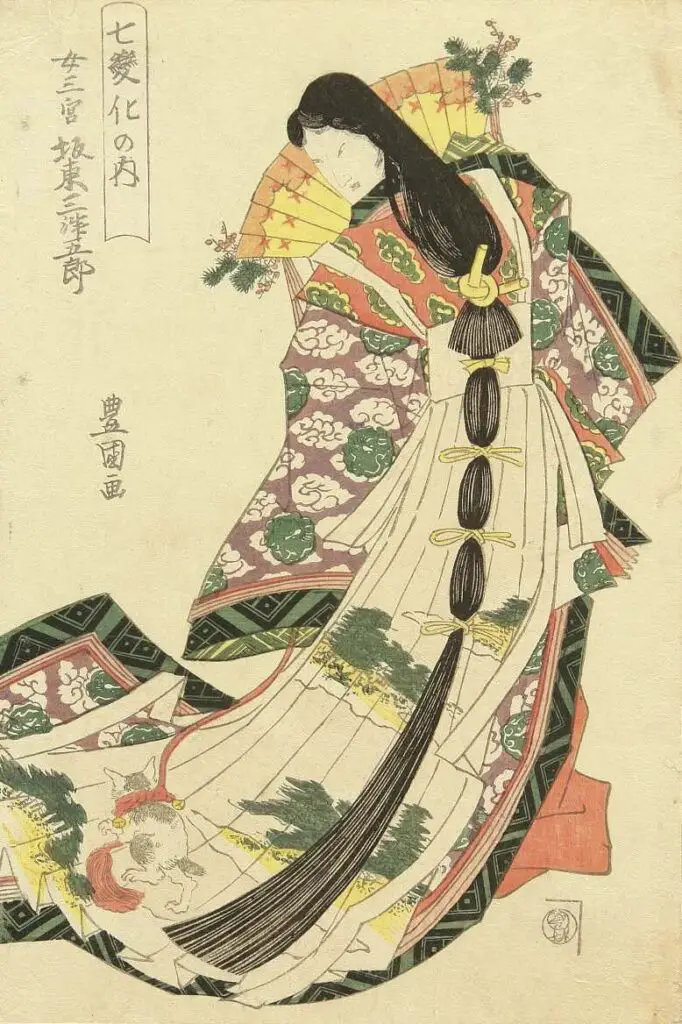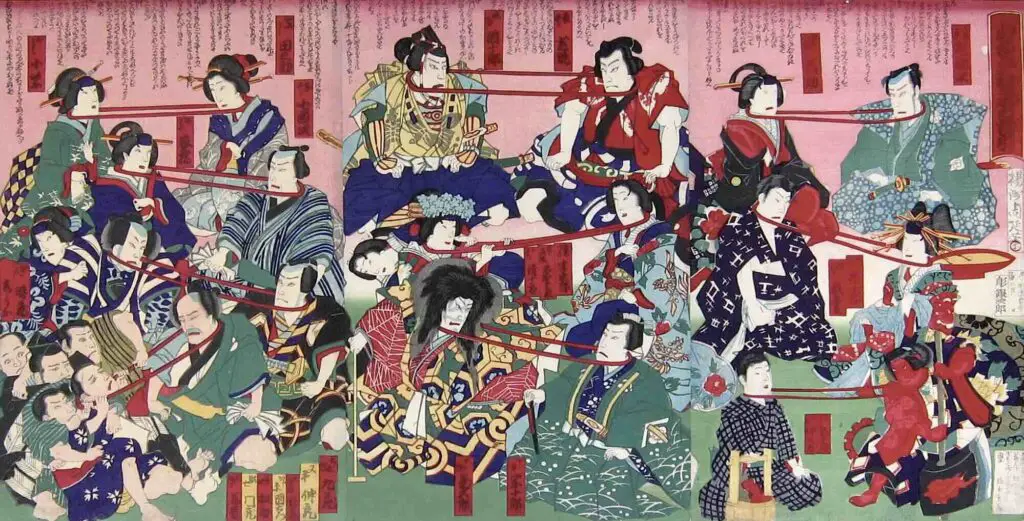Japanese woodblock prints, or ukiyo-e, are renowned for their rich depictions of everyday life, historical events, and folk tales from the Edo period.
Among the various symbols and motifs in these prints, the “toshidama” holds a unique place, particularly within the works of the Utagawa school. Read on as we delve into the cultural significance and artistic use of the toshidama in ukiyo-e art, exploring its origins, meanings, and impact on this iconic Japanese art form and why the red and gold colors’ symbolic nature is so important in Japanese culture.
Table of Contents
- Origins Of Toshidama In Ukiyo-e Woodblock Prints
- Toshidama In Ukiyo-e Art Explored
- Artistic Variations And Uses Of Toshidama Seal
- Toshidama: The Understated Artist Of The Utagawa School
- Related Questions
Origins Of Toshidama In Ukiyo-e Woodblock Prints
The term “toshidama” refers to a traditional Japanese New Year decoration. It consists of red cloth containing gold coins, often arranged in a circular form. This decoration is more than just an ornamental object; it represents good fortune, prosperity, and happiness for the coming year.
Red and gold hold profound symbolic meanings in Japanese culture. Each is imbued with significant cultural, spiritual, and aesthetic values that transcend their visual appeal.
The symbolic use of red and gold enhances this meaning, as red is considered a color of protection against evil, while gold symbolizes wealth and prestige.

The Symbolism Of Red And Toshidama
In Japanese culture, red is a color of profound significance. It is traditionally associated with protection against evil and bad fortune. This belief is rooted in ancient practices and is evident in various cultural artifacts and ceremonies.
For instance, red is prominently featured in Shinto weddings, symbolizing fertility and the sun. It’s also a common color in children’s clothing and accessories during celebrations like Shichi-Go-San, a festival for three, five, and seven-year-old children, symbolizing good health and a long life.
Red is also seen in the torii gates of Shinto shrines, which are traditionally painted vermillion.
The color is believed to act as a barrier against evil spirits and to attract kami, or divine spirits. This protective quality makes red a favored color in many traditional Japanese practices and celebrations.
The Symbolism Of Gold And Toshidama
Gold is synonymous with wealth, prestige, and status in Japanese culture. This precious metal’s bright sheen is associated with the power and warmth of the sun, making it a symbol of positivity, prosperity, and longevity. In the context of art, gold is often used in religious iconography and temples, highlighting its divine and exalted status.
Gold leaf plays a significant role in Japanese crafts and aesthetics, seen in everything from lacquerware and folding screens to the decoration of temples and palaces.
The famous Golden Pavilion (Kinkaku-ji) in Kyoto is perhaps one of the most iconic uses of gold in Japanese architecture. The upper two levels are completely covered in gold leaf, reflecting the wealth and power of its original patron and the temple’s spiritual significance.

Combined Symbolism In Art And Cultural Practices
When used together, red and gold are a powerful symbolic duo in Japanese art and decoration, especially in contexts that call for celebration, protection, and the invocation of good fortune.
These colors are often seen in New Year decorations and in the ornate designs of kimonos worn for special occasions. The combination conveys a deep respect for tradition, spiritual beliefs, and cultural values central to Japanese identity.
By incorporating these colors into various aspects of life and art, Japanese culture continues to celebrate and uphold these colors’ deep meanings and associations, enriching daily life and ceremonial practice with layers of cultural significance.
Toshidama In Ukiyo-e Art Explored
In the realm of ukiyo-e, toshidama took on a slightly different form. The Utagawa school adopted it, one of the most influential schools of Japanese woodblock printing, founded by Utagawa Toyokuni I in the late 18th century.

In their prints, the Utagawa school artists incorporated the toshidama seal—a stylized, circular motif—as a signature emblem. This symbol identified the artist’s affiliation with the Utagawa school and served as a mark of quality and artistic lineage.
Symbolic Meaning In Prints
The inclusion of the toshidama seal in ukiyo-e prints was symbolic of the blessings and good fortune the artist wished to impart to the artwork and its viewers. By integrating this emblem, artists of the Utagawa school subtly communicated their adherence to the aesthetic values and technical prowess established by their forebears.
Moreover, the toshidama seal acted as a branding tool, a way to distinguish Utagawa prints in a highly competitive market, and to assure buyers of the print’s authenticity and connection to the esteemed Utagawa lineage.
Artistic Variations And Uses Of Toshidama Seal
Each artist within the Utagawa school personalized the toshidama seal slightly, allowing for variations in design while maintaining the recognizable form of the symbol.
This practice highlighted the individual artist’s style and creativity within the shared identity of the school. The placement and treatment of the toshidama seal could also reflect the specific themes or narratives of the prints, often being subtly woven into the composition in ways that complemented the overall artwork.
Legacy And Modern Interpretations Of The Toshidama Seal
The use of the toshidama seal exemplifies how traditional symbols can be adapted for artistic expression and branding within cultural art forms.
Today, the toshidama remains a subject of interest for art historians and collectors, symbolizing the rich heritage of the Utagawa school and its significant impact on the development of ukiyo-e.
Modern artists and designers sometimes reference the toshidama in works that pay homage to this historical art style, demonstrating the enduring influence of traditional motifs.
The toshidama seal is more than just a decorative element in Japanese woodblock prints; it is a symbol rich with cultural significance and artistic identity. Its use by the Utagawa school artists not only reinforced their collective identity but also enriched the symbolic depth of their artworks, making each piece a composite of visual beauty and cultural narrative.
Toshidama: The Understated Artist Of The Utagawa School
Besides the Toshidama seal is also Toshidama the little known artist. In the grand tapestry of Japanese ukiyo-e art, some figures stand out less in the spotlight yet still contribute significantly to the cultural and artistic milieu of their time.
One such figure is Toshidama, a painter and draftsman active in the mid-19th century from approximately 1844 to 1868. While Toshidama might not have risen to widespread fame, his work and his journey as an artist offer a fascinating glimpse into the life of a minor pupil within the prestigious Utagawa school.

Artistic Beginnings And Affiliation
Toshidama was a competent artist who managed to claim affiliation with the Utagawa school, one of the most influential schools in the history of Japanese woodblock printing.
This school, founded by Utagawa Toyokuni I, was known for its rigorous training methods and the high standards it set for its students. Being part of such a school, even as a minor pupil, meant that Toshidama received a foundational education in the techniques and styles that defined this era of Japanese art.
Challenges And Contributions
Despite his affiliation with the Utagawa school, Toshidama did not receive an independent art name—a recognition often given to artists who reached a certain level of mastery and individuality in their work.
This lack of an independent art name suggests that while Toshidama was skilled enough to be part of the Utagawa community, he perhaps did not innovate or distinguish his work sufficiently to stand out among his contemporaries who achieved greater fame and recognition.
However, the value of an artist like Toshidama lies in his contribution to maintaining and carrying forward the traditional techniques and themes of the Utagawa school.
Artists like him played a crucial role in the school’s operations, helping to produce works that adhered to the school’s stylistic norms and themes, even if these works did not bear the hallmark of individual genius that characterized the leading figures of the school.
Legacy And Recognition
The story of Toshidama is a reminder of the many artists in history whose contributions go quietly noted in the annals of art history but are no less important.
His works, likely characterized by the typical Utagawa style—vibrant colors, attention to detail, and dynamic compositions—would have contributed to the school’s output and its influence on the art of ukiyo-e during a flourishing period of cultural expression in Japan.
In understanding Toshidama’s role and his artistic output, we gain a more nuanced appreciation of the Utagawa school and its lesser-known artists.
These artists, despite not achieving widespread fame, helped sustain the school’s artistic legacy and contributed to the broader tapestry of Japanese cultural history. Toshidama, like many artists of his kind, underscores the collective effort involved in the artistic movements that shape our understanding of cultural epochs.
Anita Louise Art is dedicated to art education, great artists, and inspiring others to find and create their art. We love art that uplifts and inspires. #ArtToMakeYouSmile! #ArtToMakeYouHappy!
If you are interested to see any of my art, you can find out more by clicking here. If you are interested in what inspires me and my paintings, you can discover more by clicking here.
We have a free newsletter and would love you to be part of our community; you can subscribe to the newsletter by clicking here. If you have any questions, I would be happy to talk to you. You can reach me, Anita, by clicking here.
Subscribe to our Anita Louise Art YouTube Channel filled with great videos and information by clicking here.
Join us for our podcast “5 Minutes With Art.” Spend just 5 minutes a week with us to discover and learn about great art and artists. You can find out more about our podcast by clicking here.
Related Questions
Characteristics of Japanese Ukiyo-e Woodblock Prints
Japanese woodblock prints were produced to have a mass appeal to the Japanese audience. There are a lot of characteristics in the Japanese woodblock print, such as the asymmetry of design, how the artist experiments with composition, the artist’s use of flats spaces, and the use of colors.
By clicking here, you can learn more by reading Characteristics of Japanese Ukiyo-e Woodblock Printsach Other?.
What Are Some Japanese Woodblock Print Characteristics?
There are many characteristics of a Japanese woodblock print, from the woodblock print title, artist name, and publisher’s seal; other features also include the color and subject matter. Japanese woodblock prints also have different artistic art movements.
By clicking here, you can learn more by reading What Are Some Japanese Woodblock Print Characteristics?.
What Is A Japanese Woodblock Print?
A Japanese woodblock print is, as the name implies, a print that is made by using carved woodblock and applying ink on the woodblocks to print a design on paper. The Japanese woodblock artists used woodblocks to print artistic prints and even books. Artists have used the woodblock print technique in Japan for hundreds of years.
You can learn more by reading What Is A Japanese Woodblock Print? by clicking here.

